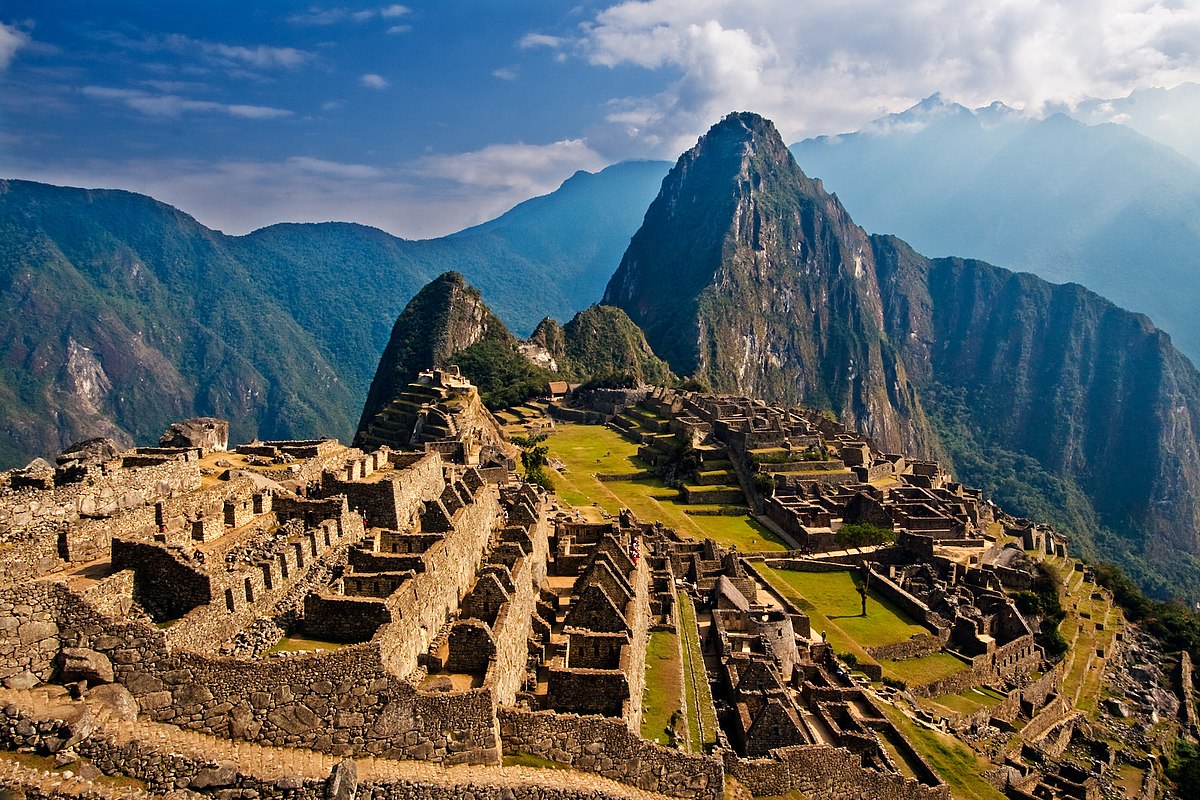Machu Picchu (Quechua Machu Picchu) is one of the most famous sights of Peru, an ancient city nestled on top of a mountain range (2.6 thousand meters above sea level), above the Sacred Valley of the Urubamba River (Spanish: Rio Urubamba), in 120 km from Cusco. The settlement in 2007 was awarded the title of “New Wonder of the World”.
Machu Pikchu means “Old Mountain” in Quechua. However, the small Machu Picchu, which has less than 200 buildings, is the owner of many unofficial titles: it is called the “Lost City”, “City among the clouds”.
Some historians suggest that it was built around 1440 as the residence of Pachacutiq Yupanki (Kech. Pachakutiq Yupanki – the great ninth ruler of the Incas, who ruled in 1438-1471), and functioned until the Spanish invasion of the empire, i. e. until 1532. To this day, the mystery remains unsolved why in 1532 all the inhabitants suddenly disappeared.

Climate
The climate in the region is subtropical and humid. The best time to visit is the dry season April-October. From November to March, there is usually heavy rainfall in the region.
The average summer temperature is +25ºС, the temperature of the winter period fluctuates around +10ºС. In these parts, high humidity, Machu Picchu is often shrouded in a veil of thick fog. But in clear weather, with good visibility from the height of the ridge, amazing views of the surroundings open up.
Flora and fauna
The picturesque archaeological ruins are inhabited by a huge species diversity of flora and fauna. Today’s territory has been explored by only 35%, according to scientists, its further study can give the world a lot of important discoveries.
Over the entire area of the lost city, which is about 32.5 thousand hectares, exotic trees grow, stunning in their grandeur, such as pisonai (lat. Arbol pisonay – Coral tree), kunyual, thyroid palm, alder. More than 400 species of orchids and begonias also grow here, of which a little more than 250 varieties have been described and systematized.
Animals living here are also striking in species diversity: there are about 375 species of birds alone here. A bright, literally and figuratively, representative of birds is the Rock Cockerel, which is considered a symbol of Peru. The bird is easily recognizable by its colorful plumage.
Among the mammals of particular interest is the Andean bear, which is known in these parts as the “Spectacled Bear”. The animal, now endangered, is absolutely safe, shy and shy, eats only plants. In Machu Picchu, you can meet white-tailed deer, vicuñas, wild llamas and many other representatives of exotic fauna.
History and architecture of Machu Picchu
Traditionally, Peru is divided into 3 regions: the mountainous Sierra (Spanish: Sierra; Peruvian Andes), the tropical valley – Montaca and the arid coastal plain. On the inaccessible mountain plateau of the Sierra, the famous city of the Incas is located, securely sheltered from prying eyes by lush, impenetrable thickets.
M-P became famous for its rich history, going back centuries and full of incomprehensible secrets. Around 1440, the great Pachacutec (Kech. Pachakutiq; 9th ruler of the Inca Empire, ruled in 1438-1471) founded this sacred city high in the mountains, which became a reliable shelter for thousands of people.
Machu Picchu was located far from the main Inca settlements, it was not destroyed by the Spanish conquerors, who conquered almost all the lands in this area, but never got here. However, in 1532, all the inhabitants suddenly mysteriously disappeared, the city was in desolation and oblivion for more than 400 years. Subsequently, this territory became an inexhaustible field of activity for archaeological research.
For a long time, only legends circulated about the “lost city of the Incas”. For certain, no one knew whether Machu Picchu really existed: not a single mention of it is found in the Spanish chronicles, and the Incas did not leave written evidence. The world learned about the existence of the city only at the beginning of the 20th century, when on July 24, 1911 it was discovered by an American archaeologist-researcher, Yale University professor Hiram Bingham (eng. Hiram Bingham; 1875-1956), who devoted more than one year to searching for the dead city .

As legend has it, Bingham climbed to the top of the mountain with a local porter guide. Here lived 2 Indian families guarding Machu Picchu. The professor gave a boy from one family a coin of 1 salt, and he showed the scientist the way to the ancient ruins, covered with dense thickets and teeming with snakes. So, for just 1 sol (about 30 US cents), humanity learned about the protected witness to the rise and fall of a great civilization.
The names that the buildings bear today actually have nothing to do with the Incas. Bingham, not knowing the old names, came up with new ones.
Despite the discovery of the “city in the clouds”, Machu Picchu remained inaccessible for almost 30 years, until an expedition of archaeologists discovered the Inca Road, laid to the citadel through the valley.
In the days of ancient civilization, access to the fortress was open only to the elite. Here lived the highest nobility, priests, artisans and “mamakunas” or Sun Maidens – virgins who devoted themselves to serving the god of the Sun. In total, about 1,200 people lived here, who worshiped the god Inti (Kech. Inti; in Inca mythology, the god of the Sun). The men were mainly engaged in agriculture. The fate of local residents is still unknown. Excavations bring more and more new mysteries.
